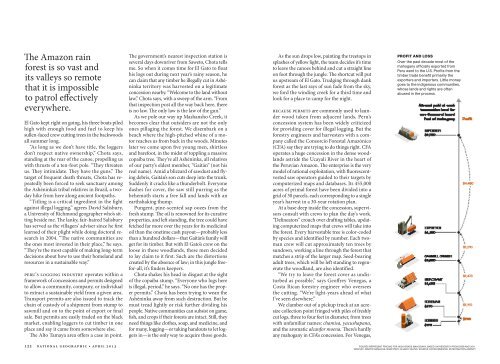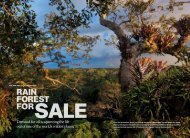Mahogany's Last Stand - Scott Wallace
Mahogany's Last Stand - Scott Wallace
Mahogany's Last Stand - Scott Wallace
Create successful ePaper yourself
Turn your PDF publications into a flip-book with our unique Google optimized e-Paper software.
The Amazon rainforest is so vast andits valleys so remotethat it is impossibleto patrol effectivelyeverywhere.El Gato kept right on going, his three boats piledhigh with enough food and fuel to keep hissullen-faced crew cutting trees in the backwoodsall summer long.“As long as we don’t have title, the loggersdon’t respect native ownership,” Chota says,standing at the rear of the canoe, propelling uswith thrusts of a ten-foot pole. “They threatenus. They intimidate. They have the guns.” Thetarget of frequent death threats, Chota has repeatedlybeen forced to seek sanctuary amongthe Ashéninka’s tribal relatives in Brazil, a twodayhike from here along ancient footpaths.“Titling is a critical ingredient in the fightagainst illegal logging,” agrees David Salisbury,a University of Richmond geographer who’s sittingbeside me. The lanky, fair-haired Salisburyhas served as the villagers’ adviser since he firstlearned of their plight while doing doctoral researchin 2004. “The native communities arethe ones most invested in their place,” he says.“They’re the most capable of making long-termdecisions about how to use their homeland andresources in a sustainable way.”Peru’s logging industry operates within aframework of concessions and permits designedto allow a community, company, or individualto extract a sustainable yield from a given area.Transport permits are also issued to track thechain of custody of a shipment from stump tosawmill and on to the point of export or finalsale. But permits are easily traded on the blackmarket, enabling loggers to cut timber in oneplace and say it came from somewhere else.The Alto Tamaya area offers a case in point.The government’s nearest inspection station isseveral days downriver from Saweto, Chota tellsme. So when it comes time for El Gato to floathis logs out during next year’s rainy season, hecan claim that any timber he illegally cut in Ashéninkaterritory was harvested on a legitimateconcession nearby. “Welcome to the land withoutlaw,” Chota says, with a sweep of the arm. “Fromthat inspection post all the way back here, thereis no law. The only law is the law of the gun.”As we pole our way up Mashansho Creek, itbecomes clear that outsiders are not the onlyones pillaging the forest. We disembark on abeach where the high-pitched whine of a motorreaches us from back in the woods. Minuteslater we come upon five young men, shirtlessand barefoot, in the midst of toppling a massivecopaiba tree. They’re all Ashéninka, all relativesof our party’s eldest member, “Gaitán” (not hisreal name). Amid a blizzard of sawdust and flyingdebris, Gaitán’s son cuts deep into the trunk.Suddenly it cracks like a thunderbolt. Everyonedashes for cover, the saw still purring as thebehemoth starts a free fall and lands with anearthshaking thump.Pungent, pine-scented sap oozes from thefresh stump. The oil is renowned for its curativeproperties, and left standing, the tree could havefetched far more over the years for its medicinaloil than the onetime cash payout—probably lessthan a hundred dollars—that Gaitán’s family willget for its timber. But with El Gato’s crew on theloose in these woodlands, these men decidedto lay claim to it first. Such are the distortionscreated by the absence of law; in this jungle freefor-all,it’s finders keepers.Chota shakes his head in disgust at the sightof the copaiba stump. “Everyone who logs hereis illegal, period,” he says. “No one has the properpermits.” Chota has been trying to wean theAshéninka away from such destruction. But hemust tread lightly or risk further dividing hispeople. Native communities can subsist on game,fish, and crops if their forests are intact. Still, theyneed things like clothes, soap, and medicine, andfor many, logging—or taking handouts to let loggersin—is the only way to acquire those goods.As the sun drops low, painting the treetops insplashes of yellow light, the team decides it’s timeto leave the canoes behind and cut a straight lineon foot through the jungle. The shortcut will putus upstream of El Gato. Trudging through dankforest as the last rays of sun fade from the sky,we ford the winding creek for a third time andlook for a place to camp for the night.Because permits are commonly used to launderwood taken from adjacent lands, Peru’sconcession system has been widely criticizedfor providing cover for illegal logging. But theforestry engineers and harvesters with a companycalled the Consorcio Forestal Amazónico(CFA) say they are trying to do things right. CFAoperates a huge concession in the dense woodlandsastride the Ucayali River in the heart ofthe Peruvian Amazon. The enterprise is the verymodel of rational exploitation, with fluorescentvestedsaw operators guided to their targets bycomputerized maps and databases. Its 455,000acres of primal forest have been divided into agrid of 30 parcels, each corresponding to a singleyear’s harvest in a 30-year rotation plan.At a base deep inside the concession, supervisorsconsult with crews to plan the day’s work.“Delineators” crouch over drafting tables, updatingcomputerized maps that crews will take intothe forest. Every harvestable tree is color-codedby species and identified by number. Each twomancrew will cut approximately ten trees bysundown, working a line through the forest thatmatches a strip of the larger map. Seed-bearingadult trees, which will be left standing to regeneratethe woodland, are also identified.“We try to leave the forest cover as undisturbedas possible,” says Geoffrey Venegas, aCosta Rican forestry engineer who overseesthe cutting. “We’re light-years ahead of whatI’ve seen elsewhere.”We clamber out of a pickup truck at an acresizecollection point fringed with piles of freshlycut logs, three to four feet in diameter, from treeswith unfamiliar names: chamisa, yacushapana,and the aromatic alcanfor moena. There’s hardlyany mahogany in CFA’s concession. For Venegas,PROFIT AND LOSSOver the past decade most of themahogany officially exported fromPeru went to the U.S. Profits from thetimber trade benefit primarily theexporters and importers. Little moneygoes to the indigenous communities,whose lands and rights are oftenabused in the process.122 national geographic • april 2013Figures represent pricING for high-grade MAHOGANY, Based on research from 2008 and 2011.GRAPHIC: MARTIN GAMACHE, NGM STAFF; ÁLVARO VALIÑO. Source: Environmental Investigation Agency




